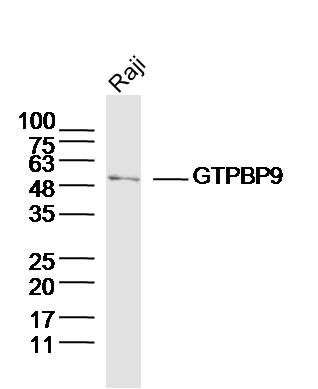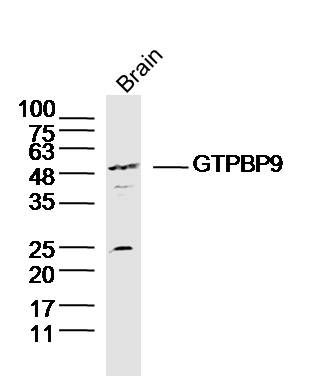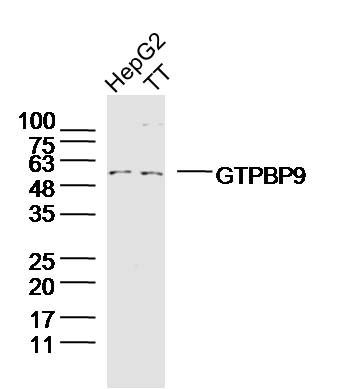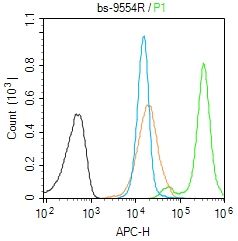| 中文名称 | 鸟嘌呤核苷酸结合蛋白9抗体 |
| 别 名 | DNA damage-regulated overexpressed in cancer 45 protein; DOC45; GBP45; GTP-binding protein 9 (putative); GTP-binding protein 9; GTP-binding protein PTD004; homologous yeast-44.2 protein; Obg like ATPase 1; Obg-like ATPase 1; OLA1; OLA1_HUMAN; PTD004. |
| 研究领域 | 细胞生物 免疫学 G蛋白信号 |
| 抗体来源 | Rabbit |
| 克隆类型 | Polyclonal |
| 交叉反应 | Human, Mouse, (predicted: Rat, Dog, Cow, Sheep, Fruit Fly, ) |
| 产品应用 | WB=1:500-2000 ELISA=1:500-1000 IHC-P=1:100-500 IHC-F=1:100-500 Flow-Cyt=1ug/Test ICC=1:100-500 IF=1:100-500 (石蜡切片需做抗原修复) not yet tested in other applications. optimal dilutions/concentrations should be determined by the end user. |
| 分 子 量 | 45kDa |
| 细胞定位 | 细胞核 细胞浆 |
| 性 状 | Liquid |
| 浓 度 | 1mg/ml |
| 免 疫 原 | KLH conjugated synthetic peptide derived from human GTPBP9:151-250/396 |
| 亚 型 | IgG |
| 纯化方法 | affinity purified by Protein A |
| 储 存 液 | 0.01M TBS(pH7.4) with 1% BSA, 0.03% Proclin300 and 50% Glycerol. |
| 保存条件 | Shipped at 4℃. Store at -20 °C for one year. Avoid repeated freeze/thaw cycles. |
| PubMed | PubMed |
| 产品介绍 | GTP-binding protein 9 is a 396 amino acid protein that belongs to the Obg-related GTPase family under the translation factors (TRAFAC) class. Originally thought to only have GTPase activity, Obg-related GTPase family members have been shown to also have ATPase activity. In Homo sapians, GTPBP9 exhibits a preference for binding ATP over GTP, with GTP binding occuring only at high nucleotide concentration. One cause for ATP affinity and GTP discrimination is thought to be a substitution of glutamine for a hydrophobic amino acid in Obg-related family members; this is the same substitution that inactivates Ras-like GTPases. GTPBP9 contains a C-terminal TGS domain that binds to ligands and an N-terminal G domain which binds nucleotides. GTPBP9 is expressed as three isoforms produced by alternative splicing. Function: Hydrolyzes ATP, and can also hydrolyze GTP with lower efficiency. Has lower affinity for GTP. Subunit: Monomer. Subcellular Location: Cytoplasm. Nucleus. Nucleus, nucleolus. Note=Predominantly cytoplasmic, shuttles between the nucleus and the cytoplasm. Tissue Specificity: Expressed in all tissues tested but its expression is more abundant in testis, liver, lung, and brain. Overexpressed in several malignancies, including cancers of the colon, rectum, ovary, lung, stomach, and uterus. Similarity: Belongs to the GTP1/OBG family. Contains 1 G (guanine nucleotide-binding) domain. SWISS: Q9NTK5 Gene ID: 29789 Database links: Entrez Gene: 29789 Human Entrez Gene: 67059 Mouse Entrez Gene: 296488 Rat Omim: 611175 Human SwissProt: Q9NTK5 Human SwissProt: Q9CZ30 Mouse SwissProt: A0JPJ7 Rat Unigene: 157351 Human Unigene: 22661 Mouse Unigene: 5874 Rat Important Note: This product as supplied is intended for research use only, not for use in human, therapeutic or diagnostic applications. |
| 产品图片 |  Sample: Raji Cell (Human) Lysate at 30 ug Sample: Raji Cell (Human) Lysate at 30 ugPrimary: Anti-GTPBP9 (bs-9554R) at 1/300 dilution Secondary: IRDye800CW Goat Anti-Rabbit IgG at 1/20000 dilution Predicted band size: 45kD Observed band size: 50kD  Sample: Brain (Mouse) Lysate at 40 ug Sample: Brain (Mouse) Lysate at 40 ugPrimary: Anti-GTPBP9 (bs-9554R) at 1/300 dilution Secondary: IRDye800CW Goat Anti-Rabbit IgG at 1/20000 dilution Predicted band size: 45kD Observed band size: 50kD  Sample: Sample:HepG2 Cell (Human) Lysate at 30 ug TT Cell (Human) Lysate at 30 ug Primary: Anti-GTPBP9 (bs-9554R) at 1/300 dilution Secondary: IRDye800CW Goat Anti-Rabbit IgG at 1/20000 dilution Predicted band size: 45kD Observed band size: 50kD  Blank control (Black line):Molt4 (Black). Blank control (Black line):Molt4 (Black).Primary Antibody (green line): Rabbit Anti-GTPBP9 antibody (bs-9554R) Dilution: 1μg /10^6 cells; Isotype Control Antibody (orange line): Rabbit IgG . Secondary Antibody (white blue line): Goat anti-rabbit IgG-AF647 Dilution: 1μg /test. Protocol The cells were fixed with 4% PFA (10min at room temperature)and then permeabilized with 90% ice-cold methanol for 20 min at room temperature. The cells were then incubated in 5%BSA to block non-specific protein-protein interactions for 30 min at room temperature .Cells stained with Primary Antibody for 30 min at room temperature. The secondary antibody used for 40 min at room temperature. Acquisition of 20,000 events was performed. |
